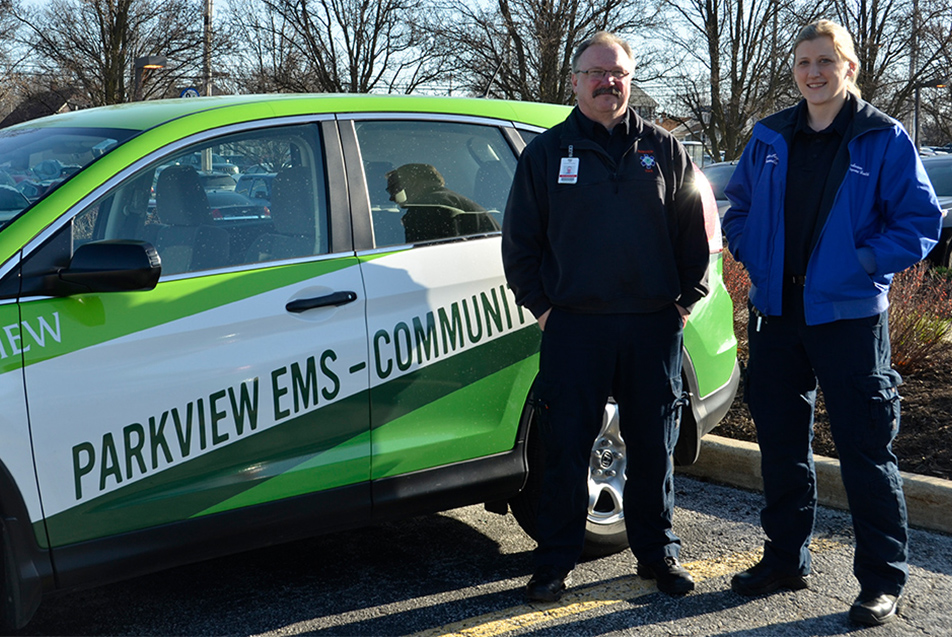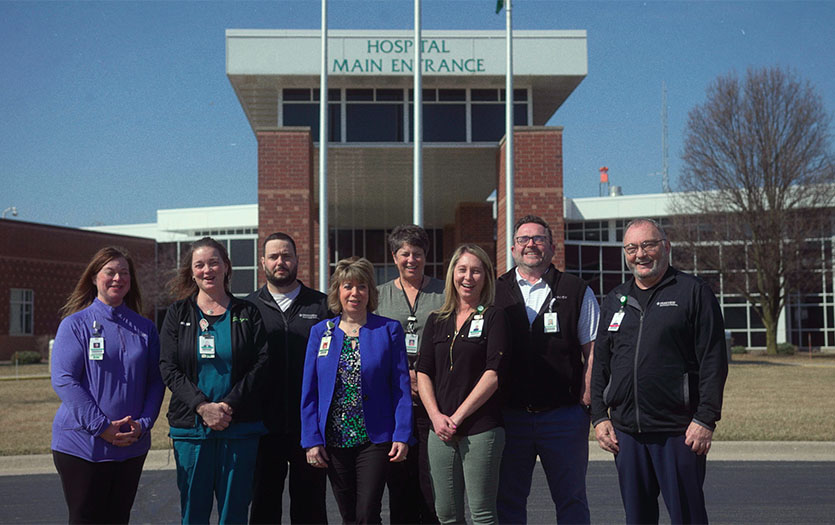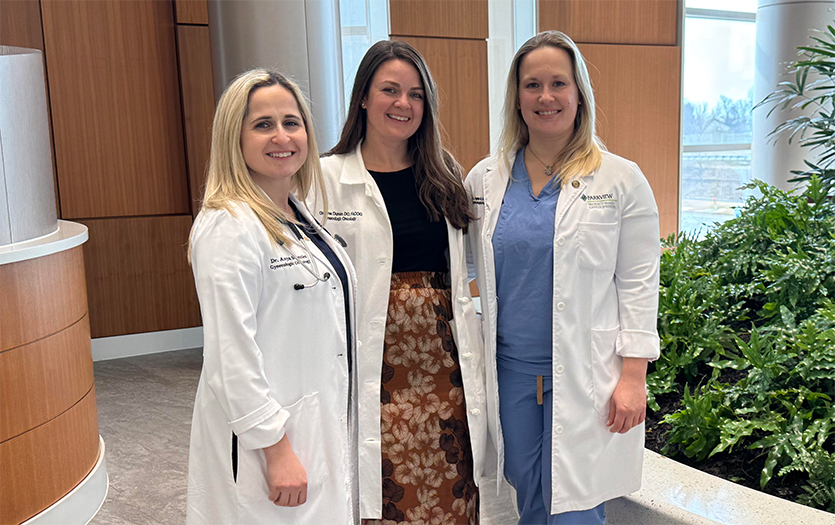
This post was written by Courtney Leach, digital/social media manager, Parkview Health.
I remember shortly after I started at Parkview, I heard the term “servant leader” for the first time. It was a title I wasn’t familiar with initially, but once I knew how it looked, felt, sounded, I started seeing it everywhere. Selfless souls walking around a universe with others at the center of it. It’s the people who stay without looking at a clock and hold someone’s hand when the hospital hallways fall silent and everyone else goes home. Once you know what to look for, you can’t miss their impact. Changing this place, changing the people in it.
Altruistic and soft spoken, Heather Cagnet, a community paramedic with the Parkview Mobile Integrated Health team, is one such soul, propelled forward by her shining servant’s heart. It only took me one shift with her to see it.
7:30 a.m.
I stood in the Emergency Room waiting area for just a few minutes before she came down the hall, prompt and polite. We shook hands and walked out to the ambulance bay where the Honda CRV wrapped in sharp Parkview green was waiting. Heather called dispatch on her phone – community paramedics don’t carry radios – while the car warmed up in the chilly shade and unseasonably cold April air.
As we pulled onto the road, it became clear that, while she was happy to oblige, having a copilot with a lot of questions isn’t something Heather’s used to. Nor is presenting, which she would be doing this morning for The Senior Health Committee, meeting at Parkview Hospital Randallia. The committee was assembled by the system’s care coordinators to fuel collaboration on Parkview’s offerings and opportunities for senior citizens in the area. Within the healthcare system, parties from population health, social workers, RNs and now community paramedics focus on treating individuals with chronic conditions so their disease won’t advance and they can stay home, rather than the hospital, when possible.
“The Mobile Integrated Health team came in to help with care and to put them in touch with the right resources,” Heather explained on the drive. “A lot of times Medicaid/Medicare won’t cover everything and these people end up in debt. We’re an entirely free service for those referred to us. A good deal of our patients are seniors, yes, but it could also be an expecting mother or even a child. We’ll help anyone the healthcare system believes needs us, 24 hours a day, 7 days a week.”
8 a.m.
We went to the lower level of Randallia where the meeting was just getting started. Along with Jeff Knee, another member of the Mobile Integrated Health team, representatives from the Center for Healthy Living, Seniors Clubs, Population Health, Trauma Services and Health and Well-being were at the table.

When it came time for Heather to present, she offered an overview of the community paramedicine initiatives. Although the program has been in place for a few years, and earning national attention, the team is still familiarizing others in the system with their role in patient care. It was Martha Bushman, RN, clinical supervisor, Population Health, who spoke up, “For example, we had a patient who just really wasn’t doing well. Finally, a community paramedic and one of our nurse practitioners went to his home and discovered he wasn’t taking his meds correctly. They kept him out of the hospital,” she said. “Really, we’re all just investigators trying to figure out how to keep people home when we can. We have a lot of patients who just need a little something, and that’s where this team is just so great.” Others in the room nodded.
“Absolutely. You know, there are times I’ll just go sit and talk to someone,” Jeff added. “because that’s what they need that day. If it makes them feel better, then that’s great.”
9 a.m.
We walked out toward the twin vehicles waiting in the parking lot, and Heather and Jeff chatted about the day ahead. Heather was anticipating a call or two from one of the five nursing homes in Allen County utilizing the community paramedics for any decline in a resident’s condition.

Jeff, a paramedic of almost 30 years, who covers Huntington, Whitley and Wabash counties, would head back to his home base at Parkview Huntington Hospital. As we spoke, it grew apparent that Jeff had established an approach to care that fit perfectly with the spirit of the smaller communities he serves; personal and accommodating.
“I’ve met people in my car outside their home because they were self-conscious and didn’t want me to come in,” Jeff shared. “I’ve met them in restaurant parking lots, the hospital church chapel. I’ve run out to get special formula for babies and taken people to the bus stop and picked up prescriptions. I’ve done it all. I get them what they need or connect them with someone who can.”
It’s a testament to the personalization this program permits. In 2016, Dan Garman, former SVP of pre-hospital and Emergency Department services, who’s now retired, identified some potential for community outreach and in-home care for those with limited financial means. Initially, the initiative was focused on reducing instances of sepsis in nursing homes and “super users” in the Emergency Department. Over time, the day-to-day workflow has evolved quite a bit. Heather pointed out that no two community paramedicine programs are the same across the nation. In fact, they aren’t even the same in our healthcare system, as demonstrated by Jeff’s tailored approach.
“I also offer respite care,” he said. “A person’s health can deteriorate so rapidly when they’re focused on caring for a loved one. I tell them to get out, go get their hair done or just take a walk.”
The ability to help those in need was only part of the appeal for Jeff. He and others relished the chance to pioneer a new program. Heather included. As a mother with two young girls, the opportunity for regular hours and a little less stress was highly attractive, though she admits she sometimes misses the rush of her former 911 runs. “But something needed to change,” she said. “This is a great balance for me.”
Jeff, Heather and the other mobile integrated care team members – Gary Dyben, Chris Moehlenkanp, Toni Wyse and Betty Schroeder – all bring at least 14 and as many as 30 years of experience to the job. They work 7:30-7:30, 36 hours one week, 48 the next. Why is 24-hour access so important?
“We get a lot of social needs; people who are depressed, suicidal,” Heather said. “They call in the evening, when they hit a low. They want to talk it out a bit. Once you walk them through their medications and empathize with their situation, then they start to feel better.”
As for the workload, in many ways the team is still making strides to strike a balance in their services and communicate those efforts to the right touchpoints in the system. “You know, we’re not home health, but we can fill in if it’s taking someone some time to get their home health care set up or if they have an immediate need. It’s defining the best use case and then serving as a resource for the right patients.”
Currently, referrals come in through care coordinators, who identify if it’s a good fit. “If they would come to us, we’ll go to them. We do home safety assessments and see people in the nursing home with complications from a UTI, upper respiratory condition, pneumonia, etc.” The team typically gets around two calls to local nursing homes. “If a resident falls, we’ll go and examine them so they don’t have to come into the ER. It gives the family peace of mind. We also do additional home visits for cases as appropriate,” Heather explained.
11 a.m.
Once back at PRMC, Heather checked the equipment before heading in. The backseat of the car is well organized with boxes of gloves, a sharps container, rolls of gauze and towels. The trunk holds an AED machine, scale, blood pressure cuff, a cardiac monitor, intubation equipment and plastic drawers, stocked with resources on financial assistance, medication cards, advanced care directives, smoking cessation and more.

“How did you end up as a paramedic?” I asked, as we made our way up to the 8th floor.
“It was 100-percent God’s sense of humor. I was always super shy. I didn’t want to branch out. I wanted to work with deceased people, actually. But some things happened and I decided to take a basic EMT class. That turned into volunteering at the fire station, then advanced EMT then I decided to become a paramedic and go full time. Now I’m 14 years in and I love it. I never thought I would do something like this but I can’t imagine being anywhere else.”
“And the shyness?”
“It’s funny, I have no problem walking into a stranger’s house and talking to them, as long as the attention isn’t always on me,” she said. “I remember when Scott Yoder was training me, he told me, and I’m paraphrasing here, that if I could make a connection with the patient and I was doing what I could, all the clinical knowledge paled in comparison. If you can make them feel like they matter, that helps more than anything.”
Heather lit up talking about her humanitarian lifestyle. Her enthusiasm was confirmation of what I’d suspected since meeting her. She’s focused on one thing, exclusively, and that’s the well-being of others. Even as I prompted and prodded with questions, my subject was far more comfortable when I offered something about myself. When I asked her about her time at the fire station, she mentioned how wonderful it was to educate the children. When we spoke of her time with TRA (10 years) she spoke of the ability to do good for others. Her favorite type of call? Bee stings/anaphylactic shock. “It’s something I can fix, right then and there. Instantly.”
Timid though she may be, Heather was answering the call to serve. Her heart was leading her back to the work of healing day after day, person after person. Her unassuming draw and relatable character play well for such work.
1 p.m.
We walked down the hallway lined with pictures of Samaritan I and II, and turned right to go into the Mobile Integrated Health office. Heather took off the sizable backpack the team shares to check the equipment. The hands-free backpack comes in handy with no partner or cot, and includes more equipment than one might guess at first glance. It includes intubation equipment, a pulse ox monitor and, perhaps most impressive, an iStat machine that allows the team to administer bedside labs for immediate results. They can run two different sets of labs: 1) Lactic acid and blood gases. Lactic acid is a huge indicator of severe sepsis, which, as you might recall, is how this whole program started. 2) Chem 6 (also called Chem 8 or BMP), which shows sodium, potassium and electrolytes. This is an indicator of kidney function. The iStat machine is stored in a thick, protective black case. Heather opens it and checks the equipment and counts the testing kits.

Once the equipment is all squared away, Heather moves on to referrals. The team gets anywhere from 3-7 a day. They will triage the cases and then decide the best course of action, which usually begins with a call to the patient. “Typically if the situation seems complicated or someone sounds tired or like they’re struggling, or if they say something like, ‘I don’t know what to do anymore,’ we know we need to go see them. Environment plays a role, too, so it can be beneficial to see where they’re living.”
There were four calls on the docket this day. I could only hear her end of the conversation: “We wanted to see if there’s anything we can do for you.” “Do you have food, transportation, a safe place to stay?” she asked. “Yeah, it can really add up.” “It sounds like you have a positive attitude.” “Please call if you need us. Anytime.”
After the conversation, the community paramedics are added to the patient’s MyChart account so they can follow up that way if they prefer.
Between calls, Heather also explains a new innovative collaboration taking shape between Parkview Heart Institute and the Mobile Integrated Health team. Recently, the paramedics began seeing all heart bypass and valve replacement patients. They first go and meet them while they’re still in the hospital, which helps give them a baseline to gauge if the patient is getting better or worse.
“A lot of times, the patient gets home and realizes they didn’t understand what the doctor said or didn’t want to ask at the time,” she explained. “Some refuse home health. They might be from out of town and staying with family and not sure where things are. They can call us any time a day. We also go to their home and follow up for a few days or weeks following their release from the hospital. We listen for an irregular heartbeat or pleural effusion. If we can catch these things early they won’t have to go through readmission. If they hit a speed bump in the healing process, we’re there for extra help. We want to keep people in their home where they’re comfortable and can heal as often as possible.”
This is the type of world class teamwork Heather predicts will only become more common for the Mobile Integrated Health program in the future.
3 p.m.
As Heather reviews patient files and referrals, she often references a large binder brimming with resources. “Isn’t this great?” she asked. “The care coordinators started just before us and had a lot of great resources already pulled together. They were kind enough to share. There are so many people and so many resources. They just don’t always meet each other.”

Together with several other teams at Parkview, this group is working tirelessly every day to cross that bridge and introduce possible solutions to those health, social and financial dilemmas.
And, as I saw countless times throughout our day together, education is a huge part of this role. Heather gave several examples of this:
- The diabetic patient who was put on a new kind of insulin. A community paramedic came to his home the same day to walk through his new medication with him.
- The woman who called because her husband was having trouble navigating his new medications, but she didn’t want him to know she called. A community paramedic went out and directed questions to him and in a short period of time, had him all squared away. “The wife recently called back and now she has cancer,” Heather said, “so we’re helping her navigate that system.”
- The gentleman who needed injections before a procedure, so a paramedic sat with him and taught him how to do them.
And on and on and on the examples went.
The community paramedicine program isn’t just about fixing the immediate problem, though that plays a part. It’s about facilitating long-term solutions and empowering patients to manage their health care. “Everyone on this team’s heart is in the right place. They care so much about the patients. And each has their own style for care. Different strengths. Betty’s good with data, Chris is good with policies and procedures. It works really well.”
4 p.m.
One of recurring themes of the day was time. The community paramedics feel privileged to have more time to spend with each patient than a typical clinician. That time might be spent giving them an exam, going over their condition in depth, reviewing medications or just listening. The minutes might seem obsolete to some, but there beyond precious to those in need of an empathetic ear and a thoughtful caregiver.
Often if a patient is still admitted when the referral comes in, someone from the team will go down for an initial introduction. At 4:15 we took materials down to a patient in the Admission Staging Unit (ASU). He was in pain, curled up and constantly twitching. As he spoke, I could hardly make out his words, though I felt every syllable from his desperate tone. He was facing his mortality, though no official diagnosis had been offered at that time. He felt something looming. He was staring regret in the face and frantically grasping at grace. Heather stood, her servant heart wide open, and kept her eyes on his. “Sometimes it’s harder to forgive ourselves,” she offered, providing the medicine he truly needed in that moment … compassion. He exhaled and closed his eyes, resting them only for one peaceful beat, before continuing his plea to her. After some time, Heather placed the resources on his side table and touched his hand. “I’m going to let you rest now, OK?” she said. And because of her, for possibly for the first time in a long time, he truly could.
“There was a magnificent human shining brightly behind her shy.” – Atticus



